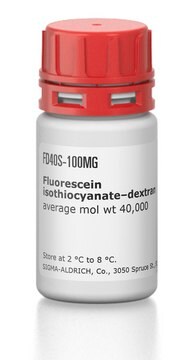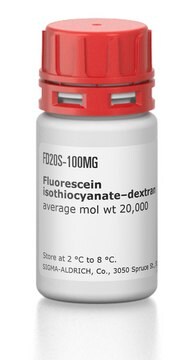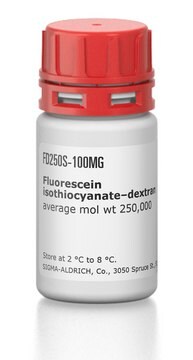46946
Isothiocyanate-dextrane marqué à la fluorescence
average mol wt 150,000, (FITC:Glucose = 1:160)
Synonyme(s) :
FITC-dextrane
About This Item
Produits recommandés
Forme
solid
Niveau de qualité
Poids mol.
average mol wt 150,000
Composition
(FITC:Glucose = 1:160)
Ampleur du marquage
~0.004 mol/mol FITC glucose
Solubilité
H2O: 25 mg/mL, slightly hazy, very deep yellow-orange
Fluorescence
λex 492 nm; λem 518 nm in 0.1 M phosphate pH 8.0
Température de stockage
2-8°C
Vous recherchez des produits similaires ? Visite Guide de comparaison des produits
Application
Autres remarques
Mention d'avertissement
Warning
Mentions de danger
Conseils de prudence
Classification des risques
Eye Irrit. 2 - Skin Irrit. 2 - STOT SE 3
Organes cibles
Respiratory system
Code de la classe de stockage
11 - Combustible Solids
Classe de danger pour l'eau (WGK)
WGK 3
Point d'éclair (°F)
Not applicable
Point d'éclair (°C)
Not applicable
Équipement de protection individuelle
Eyeshields, Gloves, type N95 (US)
Certificats d'analyse (COA)
Recherchez un Certificats d'analyse (COA) en saisissant le numéro de lot du produit. Les numéros de lot figurent sur l'étiquette du produit après les mots "Lot" ou "Batch".
Déjà en possession de ce produit ?
Retrouvez la documentation relative aux produits que vous avez récemment achetés dans la Bibliothèque de documents.
Les clients ont également consulté
Notre équipe de scientifiques dispose d'une expérience dans tous les secteurs de la recherche, notamment en sciences de la vie, science des matériaux, synthèse chimique, chromatographie, analyse et dans de nombreux autres domaines..
Contacter notre Service technique









